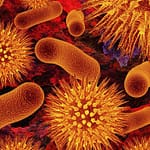 On February 26, 2015, the Advisory Committee on Dangerous Pathogens in the United Kingdom published a review of the latest research on the possible link between Mycobacterium avium, subspecies paratuberculosis (MAP) and Crohn’s disease. The last such review, conducted in 2005, determined that there was no evidence to connect MAP to Crohn’s disease. The current review was requested by Jeremy Hunt, the United Kingdom Secretary of State for Health, following a letter from a patient supporter.
On February 26, 2015, the Advisory Committee on Dangerous Pathogens in the United Kingdom published a review of the latest research on the possible link between Mycobacterium avium, subspecies paratuberculosis (MAP) and Crohn’s disease. The last such review, conducted in 2005, determined that there was no evidence to connect MAP to Crohn’s disease. The current review was requested by Jeremy Hunt, the United Kingdom Secretary of State for Health, following a letter from a patient supporter.
Dr. Irene Grant, from the Institute for Global Food Security in Belfast, looked at recent studies and expert opinions, possible associations between MAP and other human diseases and how dairy products may contribute to the spread of MAP. After initially highlighting the ongoing controversy surrounding MAP’s possible link to Crohn’s disease, she discussed studies which demonstrate that MAP is more often found in Crohn’s disease patients vs. control subjects. Whether this can be attributed to MAP as a causative agent in Crohn’s disease or a pathogen which takes advantage of a compromised mucosal lining remains to be seen. More study is warranted, but it is hard to deny that a Mycobacterial species may be involved in a sub-set of patients.
Dr. Grant then noted the success of some Crohn’s disease patients who have been treated with antibiotics designed to combat Mycobacteria. One trial in particular, the RedHill study, was mentioned as a large scale trial that could provide significant data to aid in resolving this controversy. There still remains concern about testing patients for MAP prior to antibiotic therapy and the sustained remission ability of this therapy.
In fact, it may not only be Crohn’s disease that is associated with MAP. Other inflammatory conditions may be associated with MAP, such as multiple sclerosis, Type 1 diabetes, Parkinson’s disease and autism. Dr. Grant discussed studies that attempt to show an association between MAP and these conditions, concluding that if such an association exists, it is likely in genetically susceptible individuals. In these individuals, genetic mutations hinder the immune system in its attempt to clear certain bacterial infections.
Lastly, Dr. Grant addressed the concern of MAP exposure to the human population through dairy sources. She acknowledged that the increase in Crohn’s disease worldwide may be linked to the alarming increase in Johne’s disease worldwide. (Johne’s disease is a Crohn’s like disease caused by MAP that infects cattle and other ruminants, and is highly contagious within the animal population.) Since Johne’s disease control programs are not standardized or universally effective, the threat of MAP contamination via dairy products and beef in the human population has likewise risen. Since MAP has been difficult to detect in food, data is not always reliable. However, recent advanced detection techniques have shown the alarming prevalence of MAP in dairy products, even those that have been pasteurized. More study is needed to determine how this Mycobacteria is surviving such extreme conditions.
Although firm conclusions are difficult to ascertain, certain statements can be made:
- Crohn’s disease may be more than one type of disease, MAP susceptibility being one variation.
- MAP has been detected in other human conditions, and effects may not be limited to Crohn’s disease.
- Only genetically susceptible individuals develop Crohn’s disease after MAP exposure.
- The potential of MAP exposure to humans exists based upon new detection techniques, and may affect the youngest, most vulnerable sector of the population.
To read the full report, please see the below link and scroll to view the article on Crohn’s and MAP:
